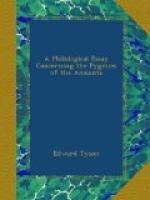An examination of the present localisation of these remnants of the Negrito inhabitants shows how they have been split up, amalgamated with, or driven to the islands by the conquering invaders. An example of what has taken place may be found in the case of Borneo, where Negritos still exist in the centre of the island. The Dyaks chase them like wild beasts, and shoot down the children, who take refuge in the trees. This will not seem in the least surprising to those who have studied the history of the relation between autochthonous races and their invaders. It is the same story that has been told of the Anglo-Saxon race in its dealings with aborigines in America, and notably, in our case, in Tasmania.
Turning from Asia to a continent more closely associated, at least in popular estimation, with pigmy races, we find in Africa several races of dwarf men, of great antiquity and surpassing interest. The discoveries of Stanley, Schweinfurth, Miani, and others have now placed at our disposal very complete information respecting the pigmies of the central part of the continent, with whom it will, therefore, be convenient to make a commencement. These pigmies appear to be divided into two tribes, which, though similar in stature, and alike distinguished by the characteristic of attaching themselves to some larger race of natives, yet present considerable points of difference, so much so as to cause Mr. Stanley to say that they are as unlike as a Scandinavian is to a Turk. “Scattered,” says the same authority,[A] “among the Balesse, between Ipoto and Mount Pisgah, and inhabiting the land between the Ngaiyu and Ituri rivers, a region equal in area to about two-thirds of Scotland, are the Wambutti, variously called Batwa, Akka, and Bazungu. These people are under-sized nomads, dwarfs or pigmies, who live in the uncleared virgin forest, and support themselves on game, which they are very expert in catching. They vary in height from three feet to four feet six inches. A full-grown adult may weigh ninety pounds. They plant their village camps three miles around a tribe of agricultural aborigines, the majority of whom are fine stalwart people. They use poisoned arrows, with which they kill elephants, and they capture other kinds of game by the use of traps.”
[Footnote A: In Darkest Africa, vol. ii. p. 92.]
The two groups are respectively called Batwa and Wambutti. The former inhabit the northern parts of the above-mentioned district, the latter the southern. The former have longish heads, long narrow faces, and small reddish eyes set close together, whilst the latter have round faces and open foreheads, gazelle-like eyes, set far apart, and rich yellow ivory complexion. Their bodies are covered with stiffish grey short hair. Two further quotations from the same source may be given to convey an idea to those ignorant of the original work, if such there be, of the appearances of these dwarfs. Speaking of the queen of a tribe of pigmies,




